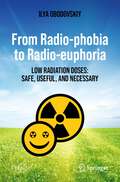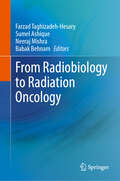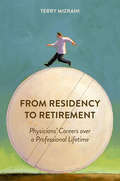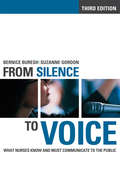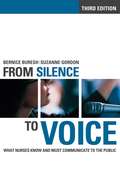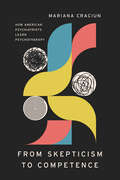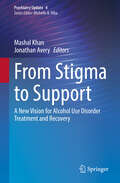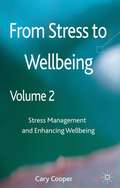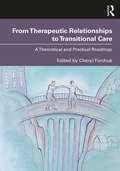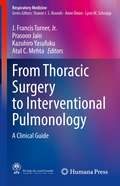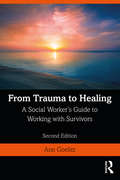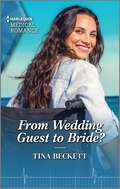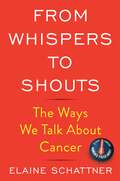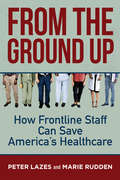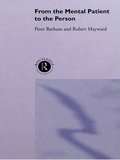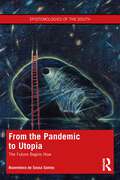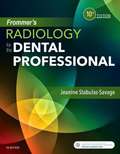- Table View
- List View
From Radio-phobia to Radio-euphoria: Low Radiation Doses: Safe, Useful, and Necessary (Springer Praxis Books)
by Ilya ObodovskiyThis book gives a detailed discussion of the initial enthusiasm triggered by the discovery of x-rays and radioactive radiation which later turned into fear and repulsion in a significant part of the global population up to the 21st century.After a historical review, the author discusses the effect of ionizing radiation on living cells, tissues and organisms. He then describes the relationship between the dose of radiation and the effect it produces. He shows how the dose-effect dependence is measured and what models of describing such dependences are used. He also discusses how radiation acts on living organisms: disorders in the genetic apparatus, mutation formation and so on. The book also includes detailed descriptions of the results of numerous health studies of large groups of people who, for one reason or another, were exposed to low doses of ionizing radiation, including those that significantly exceed the natural radiation background. The author concludes that low doses of radiation are safe and can even be beneficial (as known from medical radiation treatment); and also that the natural radiation background is necessary for the normal growth and development and well-being of a living organism. The author also discusses cases and effects of large doses, arguing, however, that dangerous doses of radiation are very unlikely. This book challenges radio-phobia. It not only offers arguments helping to overcome an unreasonable fear but, based on the latest understanding of science, argues to gradually move back, not to the former radio-euphoria, but to a new, conscious attitude towards radiation.
From Radiobiology to Radiation Oncology
by Neeraj Mishra Sumel Ashique Farzad Taghizadeh-Hesary Babak BehnamThis book offers a wide perspective on the fundamental and state-of-the-art knowledge in radiobiology, radiation oncology, and the connection between both fields. Chapters incorporate basic concepts of cancer biology and radiobiology with advances in radiotherapy in cancer treatment for various types of cancer. Chapters review one or more areas of radiation oncology with topics ranging from the application of radiotherapy in various cancers, the use of advanced techniques such as FLASH radiotherapy, applications of artificial intelligence in treatment planning, and more importantly, the current and potential strategies to reduce the toxic effects of radiation. This book incorporates interdisciplinary concepts by exploring recent approaches like radiogenomics for personalizing radiotherapy and the effects of the microbiome on radiation research. Teaching the basics of radiobiology and connections between the theory and the practical aspects of radiotherapy techniques, this book is a useful reference for cancer researchers, practitioners, interdisciplinary researchers in related fields, and students in radiation oncology and radiobiology. Through this integration of strong scientific foundations and clinical applicability, this book provides future research directions and rationales for readers looking to expand their knowledge about radiation with the most recent and essential data on the subject.
From Research to Market: A Comprehensive Guide
by Alvaro OssaUnlock the secrets to transforming research into impactful products and services that reach the market. This book is a vital resource for anyone involved in the journey from academia to commercialization. It outlines the main stages and key milestones of technology transfer in a clear and engaging manner, featuring real-world examples of successful university research outcomes. Analyse the circumstances behind their success and learn the essential steps for a successful technology transfer process. Designed as a go-to reference for researchers, doctoral and master's students, scientific entrepreneurs, and academics focused on innovation and entrepreneurship, this book is also invaluable for technology managers at universities, research centres, and public agencies. Enhance your understanding of technology transfer and gain practical knowledge to navigate this complex field successfully.
From Residency to Retirement: Physicians' Careers over a Professional Lifetime (Critical Issues in Health and Medicine)
by Terry MizrahiFrom Residency to Retirement tells the stories of twenty American doctors over the last half century, which saw a period of continuous, turbulent, and transformative changes to the U.S. health care system. The cohort’s experiences are reflective of the generation of physicians who came of age as presidents Carter and Reagan began to focus on costs and benefits of health services. Mizrahi observed and interviewed these physicians in six timeframes ending in 2016. Beginning with medical school in the mid-1970s, these physicians reveal the myriad fluctuations and uncertainties in their professional practice, working conditions, collegial relationships, and patient interactions. In their own words, they provide a “view from the front lines” both in academic and community settings. They disclose the satisfactions and strains in coping with macro policies enacted by government and insurance companies over their career trajectory. They describe their residency in internal medicine in a large southern urban medical center as a “siege mentality” which lessened as they began their careers, in Getting Rid of Patients, the title of Mizrahi’s first book (1986). As these doctors moved on in their professional lives more of their experiences were discussed in terms of dissatisfaction with financial remuneration, emotional gratification, and intellectual fulfillment. Such moments of career frustration, however, were also interspersed with moments of satisfaction at different stages of their medical careers. Particularly revealing was whether they were optimistic about the future at each stage of their career and whether they would recommend a medical career to their children. Mizrahi's subjects also divulge their private feelings of disillusionment and fear of failure given the malpractice epidemic and lawsuits threatened or actually brought against so many doctors. Mizrahi’s work, covering almost fifty years, provides rarely viewed insights into the lives of physicians over a professional life span.
From Signals to Image: A Basic Course on Medical Imaging for Engineers
by Haim Azhari John A. Kennedy Noam Weiss Lana VolokhThis textbook, intended for advanced undergraduate and graduate students, is an introduction to the physical and mathematical principles used in clinical medical imaging. The first two chapters introduce basic concepts and useful terms used in medical imaging and the tools implemented in image reconstruction, while the following chapters cover an array of topics such as: physics of x-rays and their implementation in planar and computed tomography (CT) imaging;nuclear medicine imaging and the methods of forming functional planar and single photon emission computed tomography (SPECT) images and Clinical imaging using positron emitters as radiotracers. The book also discusses the principles of MRI pulse sequencing and signal generation, gradient fields, and the methodologies implemented for image formation, form flow imaging and magnetic resonance angiography and the basic physics of acoustic waves, the different acquisition modes used in medical ultrasound, and the methodologies implemented for image formation and for flow imaging using the Doppler Effect.By the end of the book, readers will know what is expected from a medical image, will comprehend the issues involved in producing and assessing the quality of a medical image, will be able to conceptually implement this knowledge in the development of a new imaging modality, and will be able to write basic algorithms for image reconstruction. Knowledge of calculus, linear algebra, regular and partial differential equations, and a familiarity with the Fourier transform and it applications is expected, along with fluency with computer programming. The book contains exercises, homework problems, and sample exam questions that are exemplary of the main concepts and formulae students would encounter in a clinical setting.
From Silence to Voice: What Nurses Know and Must Communicate to the Public
by Suzanne Gordon Bernice BureshTo get the resources and respect they need, nurses have long had to be advocates for themselves and their profession, not just for their patients. For a decade, From Silence to Voice has provided nurses with the tools they need to explain the breath and complexity of nursing work. Bernice Buresh and Suzanne Gordon have helped nurses around the world speak up and convey to the public that nursing is more than dedication and caring-it demands specialized knowledge, expertise across a range of medical technologies, and decision-making about life-and-death issues. "Nurses and nursing organizations," they write, "must go out and tell the public what nurses really do so that patients can actually get the benefit of their expert care."The comprehensively revised and updated third edition of From Silence to Voice will help nurses construct messages using a range of traditional and new social media that accurately describe the true nature of their work. Because nurses are busy, the communication techniques in this book are designed to integrate naturally into nurses' everyday lives and to complement nurses' work with patients and families.
From Silence to Voice: What Nurses Know and Must Communicate to the Public (Third Edition)
by Suzanne Gordon Bernice BureshFor more than a decade, From Silence to Voice has been providing nurses with communication tools they can use to win the resources and respect they deserve. Now, in a timely third edition, authors Bernice Buresh and Suzanne Gordon focus on how nurses can describe and frame their work to seize unprecedented opportunities to advance their profession and lead improvements in health care systems. The authors, both journalists, argue that because nursing needs the support and cooperation of others to fulfill its potential, it is critical that nurses communicate the full scope of nursing practice. Nurses must go beyond describing nursing in terms of dedication and caring and articulate nurses' specialized knowledge and expertise. From Silence to Voice helps nurses explain their contributions to patient safety, satisfaction, and outcomes. It shows how nurses can communicate with various publics about important aspects of their work, such as how they master and employ complex medical technologies and regimens, and how they use their clinical judgment in life-and-death situations. "Nurses and nursing organizations," the authors write, must go out and tell the public what nurses really do so that patients can actually get the benefit of their expert care. This comprehensively revised and updated third edition helps nurses use a range of traditional and social media to accurately describe the true nature of their work. Its analyses of images that are projected by nursing campaigns and its detailed guidance in helping nurses construct positive and powerful narratives of their work make From Silence to Voice a must-read in nursing schools and organizations and by individual nurses in all areas of the profession. Because nurses are busy, many of the communication techniques in this book are designed to integrate naturally into nurses everyday lives and to complement nurses work with patients and families. "
From Skepticism to Competence: How American Psychiatrists Learn Psychotherapy (Ethnographic Encounters and Discoveries)
by Mariana CraciunAn examination of how novice psychiatrists come to understand the workings of the mind—and the nature of medical expertise—as they are trained in psychotherapy. While many medical professionals can physically examine the body to identify and understand its troubles—a cardiologist can take a scan of the heart, an endocrinologist can measure hormone levels, an oncologist can locate a tumor—psychiatrists have a much harder time unlocking the inner workings of the brain or its metaphysical counterpart, the mind. In From Skepticism to Competence, sociologist Mariana Craciun delves into the radical uncertainty of psychiatric work by following medical residents in the field as they learn about psychotherapeutic methods. Most are skeptical at the start. While they are well equipped to treat brain diseases through prescription drugs, they must set their expectations aside and learn how to navigate their patients’ minds. Their instructors, experienced psychotherapists, help the budding psychiatrists navigate this new professional terrain by revealing the inner workings of talk and behavioral interventions and stressing their utility in a world dominated by pharmaceutical treatments. In the process, the residents examine their own doctoring assumptions and develop new competencies in psychotherapy. Exploring the world of contemporary psychiatric training, Craciun illuminates novice physicians’ struggles to understand the nature and meaning of mental illness and, with it, their own growing medical expertise.
From Stigma to Support: A New Vision for Alcohol Use Disorder Treatment and Recovery (Psychiatry Update #4)
by Jonathan Avery Mashal KhanThis book provides the reader with a thorough understanding of the science of addiction, as well as practical tools for diagnosing, treating, and supporting individuals with alcohol use disorder. It also offers guidance for building a successful recovery and preventing relapse, and it serves as a comprehensive and evidence-based resource that brings together the latest scientific research and guidelines endorsed by expert professionals. Alcohol use disorder is a prevalent and complex disease that affects millions of people worldwide, yet is often misunderstood and stigmatized. This book is intended to contribute to reducing the stigma and misconceptions surrounding the disease and promoting access to evidence-based treatment and support. This volume is structured in a way that allows readers to move through the content in a logical and accessible manner. The first few chapters provide an overview of alcohol use disorder, its historical and cultural context, and the science of addiction. Following that, authors delve into the various causes and risk factors for alcohol use disorder, signs and symptoms, diagnosis and screening tools, and co-occurring mental health conditions. The treatment options for alcohol use disorder are covered in depth, including medication-assisted treatment, behavioral therapies, and support systems for recovery. Chapters explore ways to prevent relapse and build a successful life in recovery. Additionally, the subject of stigma and misconceptions surrounding addictions such as alcohol use disorder is discussed, as are the barriers in building greater awareness, understanding, and access to care. A chapter on advocacy and policy aims to identify and highlight various paths taken in improving access to treatment and recovery support services, and the book closes with a chapter on all the major research and promising treatments that are currently underway. From Stigma to Support: A New Vision for Alcohol Use Disorder Treatment and Recovery is a comprehensive and practical guide that will be greatly valued by psychiatrists and any other medical provider that might treat patients with alcohol use disorder.
From Stress to Wellbeing Volume 2
by Cary L. CooperA comprehensive collection by Professor Cary Cooper and his colleagues in the field of workplace stress and wellbeing, which draws on research in a number of areas including stress-strain relationships, sources of workplace stress and stressful occupations. Volume 2 of 2.
From Sugar to Splenda
by Bert Fraser-ReidMore than just coincidence connects a Tate & Lyle lawsuit and artificial sweetener to Jamaican-born Chemist Bert Fraser-Reid. From his first experience of Chemistry through his diabetic father, to his determination and drive as a Chemistry student in Canada, Fraser-Reid weaves a remarkable tale integrating science, law and autobiographical anecdotes. This book arises from the lawsuit brought by Tate & Lyle against companies accused of infringing its patents for sucralose, the sweet ingredient in the artificial sweetener SPLENDA which is made by chlorinating sugar. From a 1958 undergraduate intern witnessing the pioneering experiments on sugar chlorination, to being the 1991 recipient of the world's premiere prize for carbohydrate chemistry, Fraser-Reid was groomed for his role as expert witness in the mentioned lawsuit. Nevertheless, it seems more than his career links Fraser-Reid to the case.
From Sun to Sun: A Hospice Nurse Reflects on the Art of Dying
by Nina Angela McKissockTwenty-one people of different ages have one thing in common; they’re within six months of their deaths. They’ve endured the battle of the medical system as they sought cures for their illnesses, and are now settling in to die. Some reconcile, some don’t. Some are gracious, some not. As Nina Angela McKissock, a highly experienced hospice nurse, goes from home to home and within the residential hospice, she shares her journey of deep joy, humorous events, precious stories, and heartbreaking love. Free of religiosity, dogma, or fear, From Sun to Sun brings readers into McKissock’s world—and imparts the profound lessons she learns as she guides her beloved patients on their final journey.
From Therapeutic Relationships to Transitional Care: A Theoretical and Practical Roadmap
by Cheryl ForchukThis text provides a foundational understanding of therapeutic relationships and the transitional discharge model (TDM), a person-centered, evidence-based model that supports a smooth transition from hospital to community for people with mental illness Starting with background into the ground-breaking work of Dr. Hildegard Peplau, the mother of modern psychiatric nursing, and moving towards a transdisciplinary transitional discharge perspective, chapters introduce students and practitioners to theoretical, historical, and current perspectives on therapeutic relationships as they relate to transitional care. These perspectives foreground empirical research and practical applications that can be implemented in hospital and community settings. The Appendix features an essential "TDM toolkit" with forms, learning topics, and checklists developed by programs that implement TDM. Essential reading for those studying psychiatric nursing, this book combines theory, research, and best practices into a "roadmap" for students across nursing and psychiatric disciplines to coordinate these systems without having to implement radical changes to practice.
From Thoracic Surgery to Interventional Pulmonology: A Clinical Guide (Respiratory Medicine)
by Prasoon Jain Atul C. Mehta J. Francis Turner Jr. Kazuhiro YasufukuThis book provides an unbiased and evidence-based guide to the potential role of interventional pulmonology as an alternative to thoracic surgery. Interventional pulmonology is a new and quickly growing sub-specialty in pulmonary medicine and increasingly more pulmonologists are turning to interventional therapies over the more costly and invasive surgical options. The text thoroughly presents detailed coverage of and diagnostic methods for many diseases and conditions that pulmonologists encounter daily, including: diffuse lung infiltrates, solitary lung nodule, undiagnosed exudative pleural effusion, pneumothorax, hemoptysis, and airway foreign body. Experts then detail treatment options, from both a surgical and interventional perspective, with guidance on: when each procedure is most appropriate, what can be performed by a pulmonologist (with guidelines on how those procedures are done) versus what needs to be referred to a thoracic surgeon or an intervention pulmonologist, and the benefits and disadvantages involved with each option. This is an ideal guide for pulmonologists, trainees, and students to better understand the full scope of possible treatment options for their patients and to make the best informed decision about patient care.
From Trauma to Healing: A Social Worker's Guide to Working with Survivors
by Ann GoelitzFrom Trauma to Healing: A Social Worker’s Guide for Working With Survivors is the next significant publication on trauma in the field of social work. Since September 11 and Hurricane Katrina, social workers have come together increasingly to consider how traumatic events impact practice. From Trauma to Healing is designed to provide direction in this process, supporting both the field’s movement towards evidence-based practice and social workers’ growing need to be equipped to work with trauma. It does so in the practical-guide format already proven to be compelling to social work students, educators, and practitioners, providing case examples, and addressing social workers’ unique ecological approach.
From Trauma to Healing: A Social Worker's Guide to Working with Survivors
by Ann GoelitzThis updated edition of From Trauma to Healing is a comprehensive and practical guide to working with trauma survivors in the field of social work. Since September 11th and Hurricane Katrina, social workers have increasingly come together to consider how traumatic events impact practice. This text is designed to support the process, with a focus on evidence-based practice that ensures professionals are fully equipped to work with trauma. Highlights of this new edition include brand new chapters on practitioner bias and vulnerability, standardized assessment methodologies, and crisis management, as well as a focus on topics crucial to social workers such as Trauma Informed Care (TIC) and Adverse Childhood Events (ACES). The text also offers additional resources including chapter practice exercises and a sample trauma course syllabus for educators. With fresh examples and discussion questions to help deal with traumatic events in practice, including interventions that may be applicable to current and future 21st century world events, such as the coronavirus pandemic, From Trauma to Healing, 2nd edition remains an essential publication on trauma for students and social workers alike.
From Wedding Guest to Bride? (Night Shift in Barcelona #4)
by Tina BeckettYou&’re cordially invited to read three-time Golden Heart® Award finalist Tina Beckett&’s uplifting romance of unexpected love in this final story in the Night Shift in Barcelona series. Love was not on the doctor&’s mind……until now! When wedding guest Elena shares a mind-blowing kiss with sexy stranger Santiago, it&’s wholly out of character for the diagnostician… Elena shut her heart off to love when her childhood sweetheart walked away just as she faced a life-changing diagnosis. Still, she can&’t deny how refreshing it is to be with widower Santiago, who understands heartache more than anyone. Will he become her heart's safe haven?From Harlequin Medical: Life and love in the world of modern medicine.Night Shift in Barcelona Book 1: The Night They Never Forgot by Scarlet WilsonBook 2: Their Barcelona Baby Bombshell by Traci DouglassBook 3: Their Marriage Worth Fighting For by Louisa HeatonBook 4: From Wedding Guest to Bride? by Tina Beckett
From Whispers to Shouts: The Ways We Talk About Cancer
by Elaine SchattnerIt’s hard today to remember how recently cancer was a silent killer, a dreaded disease about which people rarely spoke in public. In hospitals and doctors’ offices, conversations about malignancy were hushed and hope was limited. In this deeply researched book, Elaine Schattner reveals a sea change—from before 1900 to the present day—in how ordinary people talk about cancer.From Whispers to Shouts examines public perception of cancer through stories in newspapers and magazines, social media, and popular culture. It probes the evolving relationship between journalists and medical specialists and illuminates the role of women and charities that distributed medical information. Schattner traces the origins of patient advocacy and activism from the 1920s onward, highlighting how, while doctors have lost control of messages about cancer, survivors have gained visibility and voice.The book’s final section lays out provocative questions facing the cancer community today—including distrust of oncologists, concerns over financial burdens, and disparities in cancer treatments and care. Schattner considers how patients and their loved ones struggle to make decisions amid conflicting information and opinions. She explores the ramifications of so much openness, good and bad, and asks: Has awareness backfired? Instead, Schattner contends, we need greater understanding of cancer’s treatability.
From a Fling to a Family (Twin Baby Bumps)
by Becky WicksIn this second installment of the Twin Baby Bumps duet by Becky Wicks, after a one-night stand with her colleague, a fertility doctor discovers she&’s pregnant with twins. But when she&’s already had IVF treatment, she soon finds she can&’t tell for certain whether her handsome doctor is the father… IS HE THEIR MISSING PIECE…? Fertility doctor Rose Carter&’s encounter with ob-gyn Dr. Lucas Bennett throws a wrench in her secret IVF plans. Rose gave up on love when she signed her divorce papers and is determined to become a mother alone. Only kind, caring Lucas challenges her stance on love and causes her to wonder if the perfect family she craves might be possible after all. Until she learns she&’s pregnant…but is Lucas the father of her babies or are they a result of the IVF?From Harlequin Medical: Life and love in the world of modern medicine. Twin Baby BumpsBook 1: A Daddy for Her BabiesBook 2: From a Fling to a Family
From an Association to a Royal College
by Alan Craft Keith DoddThis book describes the history of the Royal College of Paediatrics and Child Health (RCPCH) covering the period from 1988 to 2014, which includes the transition from the British Paediatric Association (BPA) to the formation of the now established RCPCH. The book contains a collection of viewpoints from paediatricians who held officer posts with the association and College through this time. The authors offer insights and reflections to help the reader understand where the College is at the moment on a variety of core paediatric issues, and significantly where it has come from. The formation of the RCPCH from the BPA was very controversial, with some members resigning from the RCP. Since then, the College has come a long way and is now recognised as the definitive body to speak for children's health in the UK and has forged relationships with many overseas countries. It has produced influential documents, and lobbied for advances in the practice of paediatrics. It has reported on standards for how children should be cared for in emergency and urgent care settings, launched policy to improve how children are looked after in the secure estate, and produced teaching and training materials for child protection among many other contributions to child health. Finally, it will be of interest to other Colleges and professional bodies as well as to Members and Fellows of the College.
From the Ground Up: How Frontline Staff Can Save America's Healthcare
by Peter Lazes Marie Rudden“Everyone in a hospital leadership role should read this book as it offers a wealth of practical advice for organizations intent on improving their clinical care delivery.” —Amy C. Edmondson, professor, Harvard Business School, and author of The Fearless OrganizationAll Americans deserve and should have access to high quality, affordable healthcare services delivered by professionals who have sufficient time and resources to care for them. This book offers proven and practical approaches for redesigning healthcare organizations to be less fragmented—and more patient-centered—by tapping into the experiences of staff on the front lines of patient care.Peter Lazes and Marie Rudden show how collaboration and active communication among administrators, medical staff, and patients are a core element of a successful organizational change effort. Through case studies and the direct voices and experiences of frontline workers, they explore exactly what it takes to effectively engage staff and providers in improving the patient care shortcomings within their institutions. This book not only is a manual detailing what can be achieved when frontline staff have a direct voice in controlling their practice environments but was written to show how to accomplish transformative changes in how our hospitals and outpatient clinics work. At a time when the massive gaps in our healthcare systems have been laid bare by the fragmented responses to the COVID-19 pandemic, this book offers hope and a plan for change.
From the Mental Patient to the Person: From The Mental Patient To The Person
by Robert Hayward Dr Peter Barham Peter BarhamThe aim of contemporary mental health policy is to enable people who have had a severe mental illness to lead relatively independent lives in the community, rather than be sequestered permanently in the large mental hospitals. In recent years plans to hasten the closure of many of these hospitals have become controversial and generated sharp debate about community care. From the Mental Patient to the Person contributes to this debate through an exploration of the experiences of a group of people with a history of schizophrenic illness, who are living in the community.
From the Pandemic to Utopia: The Future Begins Now (Epistemologies of the South)
by Boaventura de Sousa SantosThe coronavirus pandemic forces us to rethink our contemporaneity. It has brought to the surface dimensions of human fragility that partially contradict the euphoria and human hubris of the fourth industrial revolution (artificial intelligence). It has also aggravated the social inequality and racial discrimination that characterize our societies. The book argues that the virus, rather than an enemy, must be viewed as a pedagogue. It is trying to teach us that the deep causes of the pandemic lie in our dominant mode of production and consumption. The systemic overload of natural resources creates a metabolic rift between society and nature that destabilizes the habitat of wild animals and the vital cycles of natural regeneration whereby pandemics become an increasingly recurrent phenomenon. In trying to take seriously this lesson the book proposes a paradigmatic shift from the current civilizatory model to a new one guided by a more equitable relationship between nature and society and the priority of life, both human and non-human.
From the Watching of Shadows: The Origins of Radiological Tomography
by S. WebbFrom the Watching of Shadows: The Origins of Radiological Tomography presents the first complete history of body imaging by discrete sections, from its earliest beginnings around 1920 to modern times. Divided into two parts, the book is highly illustrated with many original figures from patents and some previously unpublished pictures. The first part covers classical tomography from 1920 to the 1960s, including the origins of radiological tomography. The second part takes a fresh look at computed transmission and emission tomography that includes recent developments by pioneering tomographers. Tables in each chapter summarize key historical landmarks. The book also includes an extensive glossary of technical terms and a comprehensive index. It is ideal reading for diagnostic radiologists and radiographers interested in the origins of their techniques, for practicing medical physicists, and for historians of medicine and science.
Frommer's Radiology for the Dental Professional
by Jeanine J. Stabulas-SavageThis full-color 10th Edition boasts new content on digital imaging, expanded information on radiation safety and infection control, plus updated new photos of the latest techniques and technology. New chapter summaries and review questions further reinforce your understanding and application skills, and feature boxes help you troubleshoot and prevent common errors.
